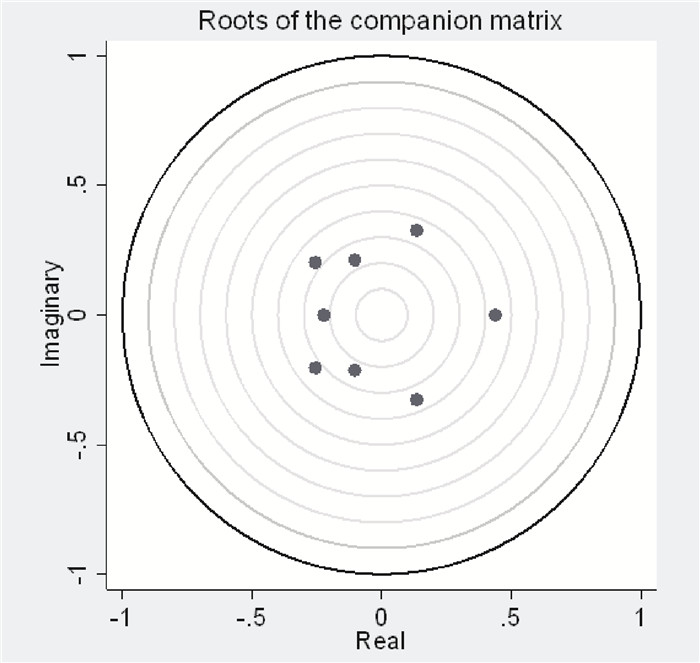Is there Inertia Development in the Impact of Innovation Drive on Economic Growth? Take 44 Countries as Examples
-
摘要: 创新驱动发展是当今具有世界意义的命题。基于1993—2018年44个国家的数据、利用面板VAR模型实证检验创新驱动与经济增长的互动关系,并对比分析劳动力驱动、投资驱动对经济增长的影响与创新驱动对经济增长影响的差别。研究发现:在世界范围内,创新驱动尚不具有惯性发展特性,创新驱动与经济增长之间不具有Granger因果关系,但两者间存在短期的互动影响效应;劳动力驱动与经济增长之间具有双向Granger因果关系,投资驱动与经济增长之间具有单向Granger因果关系,创新驱动与经济增长之间的短期互动贡献率远弱于劳动力驱动、投资驱动与经济增长之间的互动贡献率。这一结论对我国坚定创新驱动发展战略、积极构建创新与经济增长之间的正向互动关系具有重要现实意义。Abstract: Innovation-driven development is a subject all over the world.Based on the data of 44 countries from 1993 to 2018, the panel VAR model is used to empirically test the interaction between innovation drive and economic growth, and to compare and analyze the difference between the impact of labor drive and investment drive on economic growth and the impact of innovation drive on economic growth.It is found that in the world, innovation drive is not characterized with inertial development, and there is no Granger causality between innovation drive and economic growth, but the two have short-term interactive effects; there is a two-way Granger between labor drive and economic growth causality, and a one-way Granger causality between investment drive and economic growth; the short-term interaction contribution rate between innovation drive and economic growth is far weaker than the interaction contribution rate between labor drive, investment drive and economic growth. The findings are of practically significance in the implementation of China's firm innovation-driven development strategy and the active construction of a positive interactive relationship between innovation and economic growth.
-
Key words:
- economic growth /
- innovation drive /
- labor drive /
- investment drive /
- world economy /
- economic development
-
表 1 变量单位根检验
变量 LLC检验 IPS检验 ADF检验 PP检验 lnpat -7.060 3*** (0.000 0) -5.910 9*** (0.000 0) 147.264 7*** (0.000 1) 154.672 9*** (0.000 0) lab -3.462 9*** (0.000 3) -1.862 9** (0.031 2) 119.168 5** (0.015 1) 65.213 4 (0.967 2) inv -3.037 8*** (0.001 2) -3.682 3*** (0.000 1) 101.324 9 (0.156 9) 110.978 2** (0.049 5) pgdp -11.034 7*** (0.000 0) -11.506 2*** (0.000 0) 128.353 1*** (0.003 3) 370.661 2*** (0.000 0) △lnpat -22.519 1*** (0.000 0) -23.829 9*** (0.000 0) 268.515 4*** (0.000 0) 945.917 7*** (0.000 0) △lab -10.561 6*** (0.000 0) -11.279 3*** (0.000 0) 211.002 1*** (0.000 0) 393.751 6*** (0.000 0) △inv -18.605 1*** (0.000 0) -18.319 7*** (0.000 0) 218.019 9*** (0.000 0) 675.637 5*** (0.000 0) △pgdp -24.978 9*** (0.000 0) -29.774 5*** (0.000 0) 332.705 0*** (0.000 0) 1 720.236 0*** (0.000 0) 注: *、**、***分别表示在10%、5%、1%的显著性水平下拒绝原假设;检验形式为同时包含截距(c)和趋势(t);括号内数据为p值。 表 2 AIC、BIC与HQIC准则检验结果
Lag AIC BIC HQIC 1 12.684 6 13.618 13.039 1 2 12.548 5* 13.596* 12.947 2* 注:*代表各准则对应的最优期数选择。 表 3 面板VAR模型的GMM估计结果
解释变量 被解释变量 h_dlnpat h_dlab h_dinv h_dpgdp L1.h_dlnpat -0.053 (0.294) 0.016 (0.861) -0.014 (0.957) 0.201 (0.537) L1.h_dlab -0.012 (0.376) 0.281*** (0.000) 0.164 (0.129) -0.221(0.156) L1.h_dinv 0.019*** (0.002) 0.015 (0.400) -0.023 (0.782) -0.102 (0.347) L1.h_dpgdp -0.005 (0.162) 0.042*** (0.002) 0.093 (0.130) 0.440***(0.000) L2.h_dlnpat -0.028 (0.548) -0.020 (0.816) -0.412* (0.083) -0.040 (0.880) L2.h_dlab 0.006 (0.673) 0.080** (0.036) -0.095 (0.266) -0.448*** (0.001) L2.h_dinv 0.007 (0.246) -0.010 (0.589) -0.007 (0.925) -0.240***(0.002) L2.h_dpgdp 0.001 (0.848) 0.007 (0.562) 0.028 (0.319) -0.148*** (0.001) 注: *、**、***分别表示10%、5%、1%的显著性水平;h_表示已经过Helmert转换的变量;L1.h_表示滞后1期,L2.h_表示滞后2期。 表 4 面板VAR模型Granger因果检验结果
Granger检验原假设 Chi2 P-value 检验结果 专利授权量不是经济增长的Granger原因 0.439 39 0.803 接受 劳动参与率不是经济增长的Granger原因 16.388 0.000*** 拒绝 投资率不是经济增长的Granger原因 16.677 0.000*** 拒绝 经济增长不是专利授权量的Granger原因 2.595 6 0.273 接受 劳动参与率不是专利授权量的Granger原因 0.829 46 0.661 接受 投资率不是专利授权量的Granger原因 10.238 0.006*** 拒绝 专利授权量不是劳动参与率的Granger原因 0.117 0.943 接受 经济增长不是劳动参与率的Granger原因 10.215 0.006*** 拒绝 投资率不是劳动参与率的Granger原因 1.765 0.414 接受 专利授权量不是投资率的Granger原因 3.065 0.216 接受 经济增长不是投资率的Granger原因 2.314 1 0.314 接受 劳动参与率不是投资率的Granger原因 2.883 2 0.237 接受 注:***、**、*分别表示在10%、5%、1%的显著性水平下拒绝原假设。 表 5 面板VAR模型的方差分解结果
变量 期数 dlnpat dlab dinv dpgdp 1 1.000 0.000 0.000 0.000 2 0.989 0.000 0.010 0.002 dlnpat 3 0.983 0.002 0.012 0.003 4 0.983 0.002 0.012 0.003 5 0.983 0.002 0.012 0.003 1 0.001 0.999 0.000 0.000 2 0.001 0.978 0.007 0.014 dlab 3 0.001 0.977 0.008 0.014 4 0.001 0.977 0.008 0.014 5 0.001 0.977 0.008 0.014 1 0.000 0.102 0.898 0.000 2 0.000 0.109 0.879 0.012 dinv 3 0.003 0.110 0.875 0.012 4 0.003 0.111 0.874 0.012 5 0.003 0.111 0.874 0.012 1 0.000 0.093 0.142 0.764 2 0.001 0.114 0.158 0.727 dpgdp 3 0.001 0.130 0.165 0.704 4 0.001 0.130 0.168 0.700 5 0.001 0.130 0.168 0.700 -
[1] 习近平. 在省部级主要领导干部学习贯彻党的十八届五中全会精神专题研讨班上的讲话[N]. 人民日报, 2016-05-10(2). [2] 洪银兴. 创新型经济: 经济发展的新阶段[M]. 北京: 经济科学出版社, 2010. [3] 熊彼特. 经济发展理论[M]. 何畏, 易家详, 译. 北京: 商务印书馆, 1990. [4] 迈克尔·波特. 国家竞争优势[M]. 李明轩, 邱如美, 译. 北京: 华夏出版社, 2002. [5] 任保平, 郭晗. 经济发展方式转变的创新驱动机制[J]. 学术研究, 2013(2): 69-75, 159. doi: 10.3969/j.issn.1000-7326.2013.02.012 [6] 程北平, 鄢晓发, 张鹏, 等. "十三五"时期实施创新驱动发展战略的方向和重点[J]. 财政科学, 2016(2): 25-34. doi: 10.3969/j.issn.2096-1391.2016.02.004 [7] 洪银兴. 论创新驱动经济发展战略[J]. 经济学家, 2013(1): 5-11. https://www.cnki.com.cn/Article/CJFDTOTAL-JJXJ201301003.htm [8] 裴小革. 论创新驱动——马克思主义政治经济学的分析视角[J]. 经济研究, 2016(6): 17-29. https://www.cnki.com.cn/Article/CJFDTOTAL-JJYJ201606003.htm [9] 辜胜阻, 吴华君, 吴沁沁, 等. 创新驱动与核心技术突破是高质量发展的基石[J]. 中国软科学, 2018(10): 9-18. doi: 10.3969/j.issn.1002-9753.2018.10.002 [10] 周超. 创新驱动能力影响因素与经济增长质量关系研究——基于全国1990—2017年统计数据的VAR模型实证分析[J]. 工业技术经济, 2019(5): 12-18. https://www.cnki.com.cn/Article/CJFDTOTAL-GHZJ201905002.htm [11] 白俊红, 王林东. 创新驱动是否促进了经济增长质量的提升?[J]. 科学学研究, 2016(11): 1725-1735. doi: 10.3969/j.issn.1003-2053.2016.11.015 [12] 王慧艳, 李新运, 徐银良. 科技创新驱动我国经济高质量发展绩效评价及影响因素研究[J]. 经济学家, 2019(11): 64-74. https://www.cnki.com.cn/Article/CJFDTOTAL-JJXJ201911008.htm [13] 李四维, 傅强, 刘珂. 创新驱动空间溢出与区域经济收敛: 基于空间计量分析[J]. 管理工程学报, 2020(6): 191-201. https://www.cnki.com.cn/Article/CJFDTOTAL-GLGU202006020.htm [14] 丁涛, 顾金亮. 科技创新驱动江苏地区经济高质量发展的路径研究[J]. 南通大学学报: 社会科学版, 2018(4): 41-46. https://www.cnki.com.cn/Article/CJFDTOTAL-NTSX201804008.htm [15] HOLTZ-EAKIN D, NEWEY W, ROSEN H S. Estimating vector auto regression with panel data[J]. Econometric, 1988, 56(6): 1371-1395. [16] BARRO R J. Human capital and growth[J]. The American Economic Review, 2001, 91(2): 12-17. http://search.ebscohost.com/login.aspx?direct=trueu0026db=buhu0026AN=4582710u0026site=ehost-live [17] BARRO R J, X SALA-I-MARTIN. Economic growth[M]. 2nd. Cambridge: The MIT Press, 2003. [18] 台航, 崔小勇. 人力资本结构与经济增长——基于跨国面板数据的分析[J]. 世界经济文汇, 2017(2): 48-71. https://www.cnki.com.cn/Article/CJFDTOTAL-SZWH201702004.htm [19] 游士兵, 蔡远飞. 人口老龄化对经济增长影响的动态分析——基于面板VAR模型的实证分析[J]. 经济与管理, 2017(1): 22-29. https://www.cnki.com.cn/Article/CJFDTOTAL-JJGL201701006.htm [20] SIMS C A. Money, income, and causality[J]. American Economic Review, 1972, 62(4): 540-552. http://www.onacademic.com/detail/journal_1000036527450310_6d87.html [21] GEWEKE J, MEESE R, DENT W. Comparing alternative tests of causality in temporal systems: analytic results and experimental evidence[J]. Journal of Econometrics, 1983, 21(2): 161-194. http://www.sciencedirect.com/science/article/pii/030440768390012X [22] GRANGER C W J. Investigating causal relations by econometric models and cross-spectral methods[J]. Econometrica, 1969, 37(3): 424-438. [23] GRANGER C W J. Some recent developments in a concept of causality[J]. Journal of Econometrics, 1988, 39(1-2): 199-211. doi: 10.1017/cbo9780511753978.004 [24] JAMES D H. Time series analysis[M]. Princeton: Princeton University Press, 1994. [25] LUTKEPOHL H. The new palgrave dictionary of economics[M]. New York: Palgrave Macmillan, 2008. [26] SIMS C A. Macroeconomics and reality[J]. Econometrica, 1980, 48(1): 1-48. [27] ABDULLAH D A, RANGAZAS P C. Money and the business cycle: another look[J]. Review of Economics and Statistics, 1988, 70: 680-685. -





 下载:
下载:


